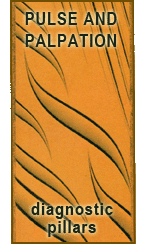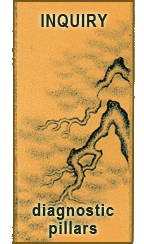Pulse Qualities and Mechanisms (A Quick Guide)

Pulse diagnosis is among the more difficult aspects of Chinese medicine to master. One reason for this is incomplete education.
In this article, pulse qualities are described, along with the mechanisms behind these findings and of course their therapeutic indications.
Understanding mechanisms simplifies this study greatly. Complex pulses such as the soggy (ru mai) aren’t so complex when you understand the basis for it’s quantifiable parameters.
 Last modified: September 11, 2009 ·
Last modified: September 11, 2009 ·  al ·
al ·  No Comments
No Comments
 Tags: Diagnosis, Palpation, study guide · Posted in: Pulse-Palpation
Tags: Diagnosis, Palpation, study guide · Posted in: Pulse-Palpation
Generalities to Guide Clinical Practice (A Quick Guide)

There are certain answers that come up frequently during the “inquiry” phase of the diagnostic interaction in Chinese medicine.
For instance, whenever you see secretions or excretions that are yellow, no matter where they appear, the diagnostic significance always points to heat.
These generalities can easily guide a practitioner toward relevant, accurate, and efficacious diagnosis. Enjoy.
 Last modified: September 11, 2009 ·
Last modified: September 11, 2009 ·  al ·
al ·  No Comments
No Comments
 Tags: Diagnosis, inquiry, Listening, Observation, Palpation, Smelling, study guide · Posted in: Inquiry
Tags: Diagnosis, inquiry, Listening, Observation, Palpation, Smelling, study guide · Posted in: Inquiry
Pulse Diagnosis Made Ridiculously Simple (Page 1 of 45)

Making pulse diagnosis doable by breaking down complex qualities into very quantifiable perceptions.
 Last modified: August 27, 2009 ·
Last modified: August 27, 2009 ·  al ·
al ·  No Comments
No Comments
 Tags: Diagnosis, Palpation, study guide · Posted in: Pulse Class, Pulse-Palpation
Tags: Diagnosis, Palpation, study guide · Posted in: Pulse Class, Pulse-Palpation
Pulse Education and Translation Problems

One of the more frustrating problems Chinese medicine folks have in the English speaking world is getting past translations of pulse terms to arrive at less ambiguous descriptions of these different pulses.
 Last modified: August 25, 2009 ·
Last modified: August 25, 2009 ·  al ·
al ·  No Comments
No Comments
 Tags: Diagnosis, Palpation · Posted in: Pulse Class, Pulse-Palpation
Tags: Diagnosis, Palpation · Posted in: Pulse Class, Pulse-Palpation
Simple Pulse Qualities

These first six pairs of ridiculously simple pulse measurements don’t rely on intuition, self-cultivation, or psychic abilities.
 Last modified: August 23, 2009 ·
Last modified: August 23, 2009 ·  al ·
al ·  No Comments
No Comments
 Tags: Diagnosis, Palpation · Posted in: Pulse Class, Pulse-Palpation
Tags: Diagnosis, Palpation · Posted in: Pulse Class, Pulse-Palpation
Simple Pulse Qualities: Depth

Depth: deep-superficial The deep pulse is associated with either a deficiency of yang qi to lift the pulse upward, or an obstruction to the yang qi that prevents it from rising systemically and lifting the pulse.
 Last modified: August 22, 2009 ·
Last modified: August 22, 2009 ·  al ·
al ·  No Comments
No Comments
 Tags: Diagnosis, Palpation · Posted in: Pulse Class, Pulse-Palpation
Tags: Diagnosis, Palpation · Posted in: Pulse Class, Pulse-Palpation
Simple Pulse Qualities: Rate

The slow pulse is due to a deficiency of pulse power as manifest in its rate rather than strength.
 Last modified: August 21, 2009 ·
Last modified: August 21, 2009 ·  al ·
al ·  No Comments
No Comments
 Tags: Diagnosis, Palpation · Posted in: Pulse Class, Pulse-Palpation
Tags: Diagnosis, Palpation · Posted in: Pulse Class, Pulse-Palpation
Simple Pulse Qualities: Rhythm

Rhythm: rhythmic-arrhythmic Again, this comes down to the Heart’s yang (or qi in the absence of cold symptoms) from flowing smoothly.
 Last modified: August 20, 2009 ·
Last modified: August 20, 2009 ·  al ·
al ·  No Comments
No Comments
 Tags: Diagnosis, Palpation · Posted in: Pulse Class, Pulse-Palpation
Tags: Diagnosis, Palpation · Posted in: Pulse Class, Pulse-Palpation
Simple Pulse Qualities: Strength

If there is one pulse quality that should be a take-home message, it is this. The forceful pulse suggests excess, the forceless pulse suggests deficiency.
 Last modified: August 19, 2009 ·
Last modified: August 19, 2009 ·  al ·
al ·  No Comments
No Comments
 Tags: Diagnosis, Palpation · Posted in: Pulse Class, Pulse-Palpation
Tags: Diagnosis, Palpation · Posted in: Pulse Class, Pulse-Palpation
Simple Pulse Qualities: Length

Length: short-long. If the strength of the pulse is the best tie breaking quality to differentiate between excess and deficiency, the length of the pulse is the least likely to help you understand anything.
 Last modified: August 17, 2009 ·
Last modified: August 17, 2009 ·  al ·
al ·  No Comments
No Comments
 Tags: Diagnosis, Palpation · Posted in: Pulse Class, Pulse-Palpation
Tags: Diagnosis, Palpation · Posted in: Pulse Class, Pulse-Palpation
